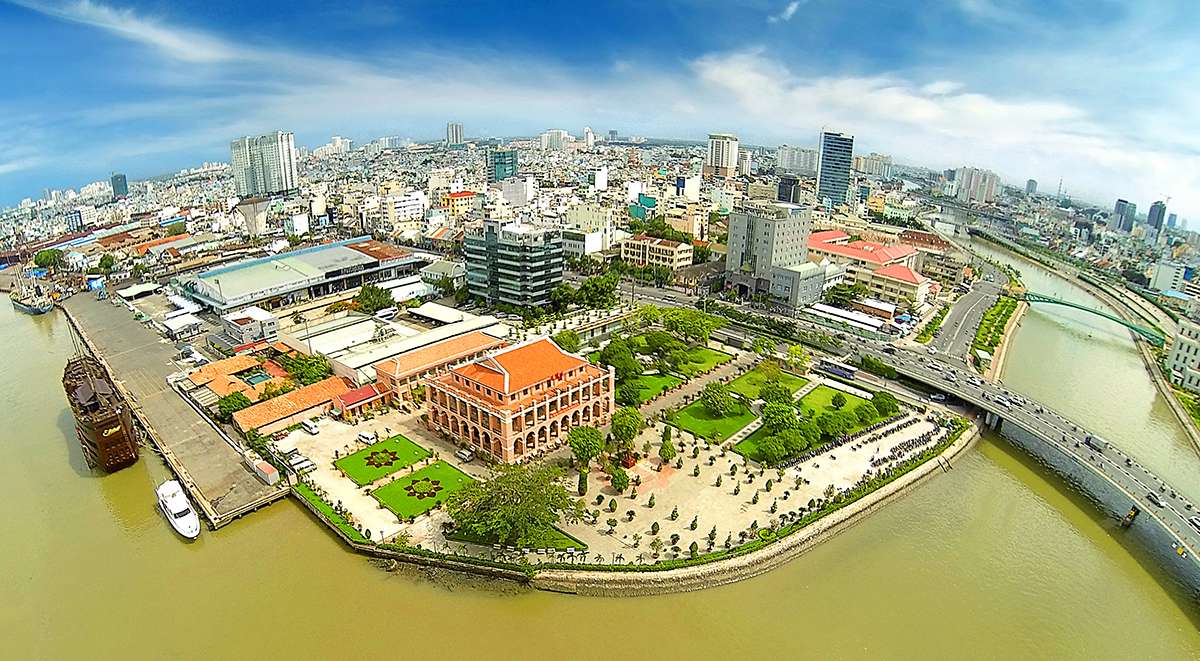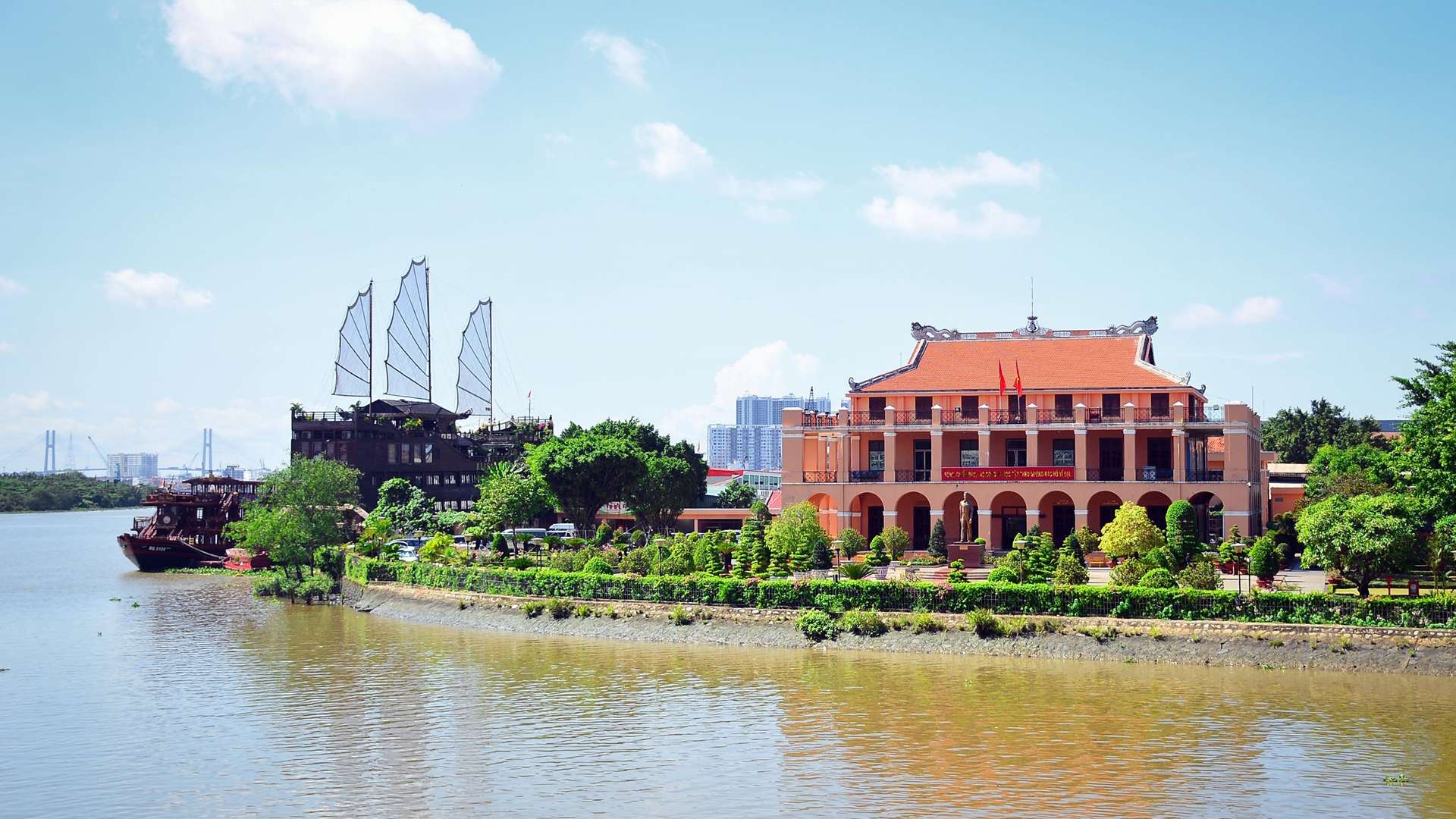Nha Rong Wharf is one of Vietnam’s most famous landmarks with great historical significance. It was from this very place that the great leader of the Vietnamese people, President Ho Chi Minh, began his more than 30-year journey to seek a path to national salvation.

1. Where is Nha Rong Wharf? General Information
Address: No. 01 Nguyen Tat Thanh Street, Ward 12, District 4, Ho Chi Minh City
Opening days: Tuesday to Sunday
Opening hours: Morning: 7:30 AM – 11:30 AM; Afternoon: 1:30 PM – 5:00 PM
Entrance fee: 20,000 VND/person
How to get to Nha Rong Wharf:
Personal vehicles: The route to Nha Rong Wharf is relatively easy. There is a separate parking area, so you can ride a motorbike or drive a car. This option gives you more flexibility in travel time and allows convenient access to other destinations.
Bus: You can reach the wharf by taking buses No. 02, 03, 19, or 56.
Group tour vehicle rental: For groups, renting a tourist vehicle with a specific itinerary is a great option for convenience and comfort.
2. Learn About Nha Rong Wharf in Saigon
2.1. When was Nha Rong Wharf built?

Originally, Nha Rong Wharf was the headquarters of the Saigon Commercial Port, built by the French colonists in 1863. After the war, it was handed over to the government of Southern Vietnam, who renovated and redesigned the structure. Today, it serves as a branch of the Ho Chi Minh Museum system across the country.
2.2. What historical event happened at Nha Rong Wharf?
Nha Rong Wharf holds special historical significance as the place where President Ho Chi Minh departed on his journey to seek national salvation on June 5, 1911. At the time, under the alias Van Ba, he boarded the ship Amiral Latouche-Tréville with a burning desire to find a path to free Vietnam from colonial rule.
This event marked a major turning point in his revolutionary journey and was the starting milestone in Vietnam’s fight for independence. Today, Nha Rong Wharf is a sacred historical and cultural site, attracting numerous visitors who come to pay tribute and learn about the great patriotism of President Ho Chi Minh.
2.3. Structure of Nha Rong Wharf
The renovated Nha Rong Wharf now includes several main areas: the Ho Chi Minh Museum, the statue of President Ho, a fountain, and the harbor premises.
The Ho Chi Minh Museum consists of a ground floor and two upper floors, with 7 exhibition rooms across 8 themed galleries covering more than 1,500 m². The roof features the traditional Vietnamese motif “Two Dragons Flanking the Moon” commonly seen in temples and pagodas. Due to this design, locals began calling the structure “Nha Rong” (Dragon House), and the nearby wharf became known as Nha Rong Wharf.
Currently, the museum preserves many documents, artifacts, and images related to Ho Chi Minh’s revolutionary activities during the resistance era.
3. What to Do at Nha Rong Wharf
3.1. Visit the Ho Chi Minh Museum
Today, Nha Rong Wharf is the Ho Chi Minh Museum – Ho Chi Minh City Branch, part of a museum-architecture complex located by the Saigon River. The museum presents the life and revolutionary career of President Ho Chi Minh in a vivid and systematic way.

Covering 1,500 m² with one ground floor and two upper floors, the museum includes 9 exhibition rooms. It features Western-style architecture with large pillars, numerous surrounding windows, and a grand, elegant space. Visitors can explore various themes, including:
Theme 1: Childhood and youth of Ho Chi Minh, and his early revolutionary activities (1890–1920)
Theme 2: Ho Chi Minh’s creative application of Lenin’s ideology and the founding of Vietnam’s first proletarian political party (1920–1930)
Theme 3: Leadership of the August Revolution and the establishment of the Democratic Republic of Vietnam (1930–1954)
Theme 4: Leading the socialist revolution in the North and directing the national liberation struggle in the South (1954–1969)
Theme 5: Vietnamese people fulfilling his will, completing the struggle for independence, and building a prosperous country (1969–present)
3.2. Stroll and Sightsee at Nha Rong Wharf

Aside from visiting the museum, tourists can also enjoy the open space and beautiful scenery of Nha Rong Wharf. Located by the Saigon River, the wharf offers a stunning view of the Thu Ngu Flagpole and the bustling Bach Dang Wharf in District 1.
Walking along the riverbank, visitors can admire the romantic Saigon River, especially at night when luxurious cruise ships are docked, creating a magical scene. Despite being in the heart of a dynamic and modern city, Nha Rong Wharf retains its ancient architecture and historical charm. It is an ideal place to relax, enjoy fresh air, and capture memorable moments.
4. Suggested Attractions Near Nha Rong Wharf
4.1. Bach Dang Wharf
Less than 1 km away is the famous Bach Dang Wharf – a popular tourist spot where visitors can enjoy the riverside views and Saigon cuisine. In the late afternoon, many people come here to walk, relax, and sip coffee by the river.
4.2. Independence Palace – Just 2 km from Nha Rong Wharf
On your Saigon travel map, don’t miss the Independence Palace – a historic landmark that houses wartime documents and regularly hosts exhibitions showcasing Vietnam’s past.
4.3. Cu Chi Tunnels
For those who love exploration, the Cu Chi Tunnels are an ideal destination. Known as an “underground maze,” it was a key base for Vietnamese troops during the resistance war. Today, the tunnels are open to tourists for exploration and feature delicious local cuisine.
4.4. Saigon Opera House
A prominent night-time attraction in Saigon, just 1.4 km from Nha Rong Wharf, is the Saigon Opera House. This Gothic-style building regularly hosts major art performances and cultural events in the city.
After exploring Nha Rong Wharf and nearby attractions, don’t forget to visit Grand Park Thu Duc – one of Vietnam’s premier entertainment paradises. It features a world-class water park, thrilling rides, and exciting activities like carousel rides, adventure trains, and games of chance.
